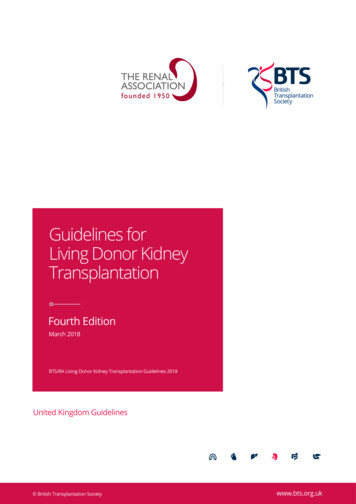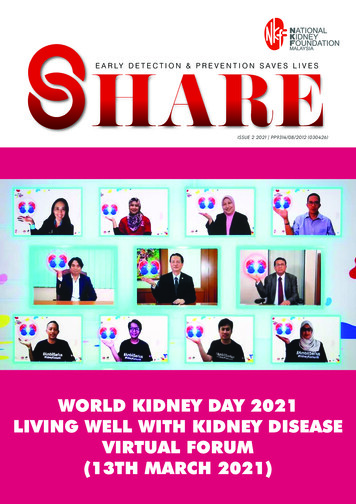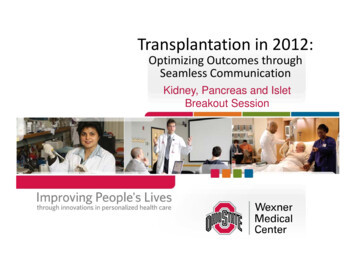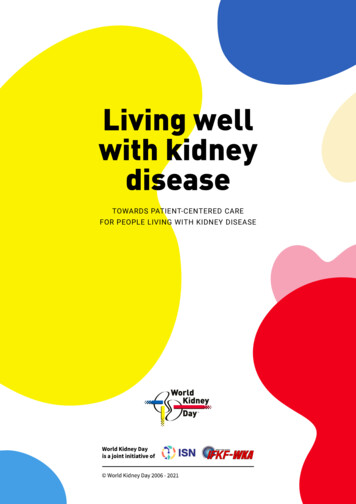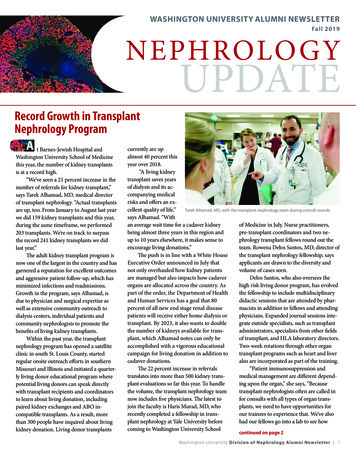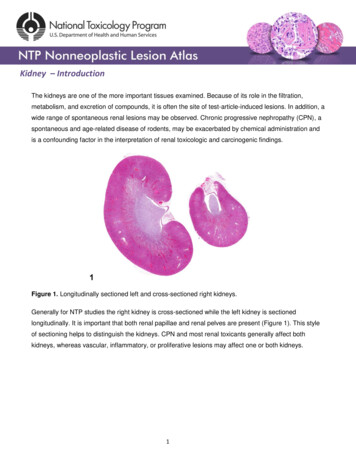
Transcription
LIVING DONATIONWhat You Need to Knowwww.kidney.org
2NATIONAL KIDNEY FOUNDATION
TABLE OF CONTENTSAbout Living Donation. . . . . . . . . . . . . . . . . . . . . 4The Evaluation Process. . . . . . . . . . . . . . . . . . . . . 6Surgery and Recovery. . . . . . . . . . . . . . . . . . . . 12After Donation. . . . . . . . . . . . . . . . . . . . . . . . . . . 17Making an Informed Decision . . . . . . . . . . . . . . 20More Information . . . . . . . . . . . . . . . . . . . . . . . . 22WWW.KIDNEY.ORG3
ABOUT LIVING DONATIONIntroductionDonating a kidney is a generous act that can help improveanother person’s life. It allows someone whose own kidneyshave failed to live without needing dialysis. If you are thinkingof donating a kidney, you should learn as much as you canfrom many different sources. This brochure will help you getstarted. It will give you some basic information aboutliving donation.What is living donation?Living donation takes place when a living person donates anorgan (or part of an organ) to another person. The personwho donates an organ is called a “living donor.”The living donor can be a family member, friend, or spouse.In some cases, it could even be someone you’ve never met.The kidney is the most common organ that is donated by aliving person. However, it’s also possible to donate part ofyour liver, pancreas, lung, bone marrow, or intestine. Thisbrochure will focus on living kidney donation.Who can be a living kidney donor?To donate a kidney, you must be in good physical and mentalhealth. As a general rule, you should be 18 years or older.You must also have normal kidney function. There are somemedical conditions that could prevent you from being aliving donor. These include having uncontrolled high bloodpressure, diabetes, cancer, HIV, hepatitis, or acute infections.Having a serious mental health condition that requirestreatment may also prevent you from being a donor.4NATIONAL KIDNEY FOUNDATION
Are there different types of living donation?There are two main types of living donation:Directed donationThis is when the donor names a specific person who willreceive the kidney. It is the most common type of livingdonation. Directed donations are often between bloodrelatives, like parents, siblings, or children. They can alsooccur between people with close personal relationships, suchas a spouse, friend, or coworker.Nondirected donationThis is when a person does not name a specific person whowill get the kidney. In this case, the donor is matched withsomeone in need.How long does a transplanted kidney last?On average, a kidney from a living donor lasts about 15 to 20years. Some will last longer; others might last less.WWW.KIDNEY.ORG5
THE EVALUATION PROCESSHow do I donate a kidney?If you want to donate to someone you know, your first stepis to talk to him or her and the transplant center where theperson is listed. Transplant centers are hospitals that performkidney transplant operations.If you are interested in donating to someone in need asa nondirected donor, contact a transplant center of yourchoice. Let them know you are interested in donating akidney to someone in need.Becoming a living donor has many benefits, but it also hasrisks. Your decision to donate will affect the lives of yourfamily members as well, so it should not be taken lightly.Learn all you can about the process, evaluation, surgery, andrecovery. Make sure you consider how donation will affectyour life, including your family relationships, your finances,your health, and your employment. Talk with family members,6NATIONAL KIDNEY FOUNDATION
friends, and others you trust. Be sure to include people youtrust in your decision-making process. You may also beinterested in speaking with other living kidney donors to learnmore about their experiences.What will happen after I contact a transplant center?After you contact the transplant center staff, they will begina basic medical screening. They will ask you questions aboutyour medical history to find out if you have any conditionsthat would prevent you from donating. You may be senta health questionnaire to fill out. This initial screeningis followed by a blood test to find out whether you arecompatible with the recipient.You will also be assigned an Independent Living DonorAdvocate (ILDA), who will assist you during the donationprocess. This person’s sole job is to look after your bestinterest. They will answer your questions and help you getinformation. They will also make sure you understand thepossible risks and benefits of donation, and any impact itmay have on your emotional life, finances, family, futureemployment, and health. Everything that is discussedbetween you and the ILDA is kept private and confidential.If you are interested in donating a kidney, you will start a fullevaluation process. This serves two purposes—to protect youand to help ensure the success of the transplant.WWW.KIDNEY.ORG7
What does a “full evaluation” involve?You must complete a financial consultation, a psychologicalevaluation, and extensive medical tests. The results will bekept completely confidential. They will not be shared withthe recipient.Financial consultationStaff at your transplant center will ask about your financesand insurance coverage. In general, if you are donating to afamily member or friend, the recipient's insurance will payyour expenses for testing and surgery. However, you maybe responsible for travel expenses, lost wages, and somefollow-up care. If any health problems that require treatmentare discovered during your medical tests, you or your healthinsurance will be responsible for them.Psychological evaluationThe transplant team makes sure that each donor is in goodmental health and understands the donation process. Theywill educate you about all aspects of living donation andmake sure you are able to make an informed decision.8NATIONAL KIDNEY FOUNDATION
One reason this is done is to make sure there is no pressurefrom friends or family, no promise of financial incentive, andthat your expectations are realistic. This is also an opportunityfor you to express yourself more fully than you might be ableto with family or the recipient present.Medical testsThe following is a general description of the medical tests.The process may vary from center to center. Medical history. You will be asked to give a completeand thorough history of any illnesses, surgeries, andtreatments you’ve had in the past. You will also be askedabout your family’s medical history. If any problems orabnormalities are found, they will be investigated further. .Physical exam. You will be given a physical examination tomake sure you are healthy enough to donate a kidney. Chest X-ray and electrocardiogram (EKG). These tests aredone to check for heart or lung disease. Radiological testing. These tests allow physicians to lookat your kidney, including its blood vessel supply. Urine testing. A 24-hour urine sample is collected tomake sure you have good kidney function. If it is foundthat your kidney function is low, they will most likelyadvise against donation. Gynecological examination. Female donors may need tohave a gynecological exam and mammography. Cancer screening. You may also be given some cancerscreening tests, which may include a colonoscopy,prostate exam, and skin cancer screening.WWW.KIDNEY.ORG9
Compatibility tests. A blood sample will be taken tocheck for compatibility between you and the recipient.This includes:Blood typing. Your blood type will be checked to see ifit is compatible with the recipient.Tissue typing. This blood test checks the tissue matchbetween your white blood cells and the recipient’swhite blood cells.Crossmatching. In this test, blood cells from thedonor and recipient are mixed. If the recipient’s cellsattack and destroy the donor cells, the crossmatchis positive. A “positive” crossmatch means that yourorgan will not match the recipient’s. A “negative”crossmatch means that your organ is compatiblewith the recipient’s.10NATIONAL KIDNEY FOUNDATION
Other blood tests. Additional blood tests are done tocheck for any viral activity or transmissible diseases(like HIV/AIDS, hepatitis, cancer, or others), glucoseintolerance, electrolyte balance, and to assess yourkidney function.What if my kidney is not compatible with myintended recipient?You may consider a “paired exchange.” A paired exchangeinvolves two pairs of living donors and their recipients. Thetwo recipients “swap” donors so that each receives a kidneyfrom a compatible donor. If this is an option for you, yourtransplant team will coordinate the entire process, includingfinding the matching pair.How long does the evaluation process take?The length of time it takes to complete the evaluation processis different for each person. It will depend on your availabilityfor testing, the results of your tests, and the individualpolicies and procedures of the transplant center involved. Ifthe recipient’s transplant center is far away, you may be ableto complete some tests at a hospital or lab near your home.What happens after the evaluation is complete?Your test results will be sent to the transplant team, who willreview them carefully. They will make a decision about yourphysical health and suitability as a donor. If you are a suitablecandidate for living donation, and you decide to go aheadwith it, an operation will be scheduled. The final decision toproceed will be a group decision among you, your recipient,and the transplant team.WWW.KIDNEY.ORG11
SURGERY AND RECOVERYWhat does the operation involve?In general, you will be given a general anesthetic in theoperating room. You will be asleep and will not feel any painduring the surgery. In most cases, you and your recipient willbe in adjacent operating rooms. One of your kidneys will becarefully removed and transplanted in the recipient. Typically,the surgery takes 3–5 hours with time in the recovery roomafterward for observation. Removing your kidney may bedone by laparoscopy or open surgery. The surgery to removea kidney is called a “nephrectomy.” Laparoscopy is the preferred method for kidney donortransplants. It involves the use of a laparoscope (wand-likecamera) that is passed through a series of small incisionsor “ports” in the abdominal wall (stomach). It is used toview the abdominal cavity and remove the kidney througha small incision. The advantages of laparoscopic surgeryinclude shorter recovery time, shorter hospital stay,smaller incisions, and fewer post-operative complications.Laparoscopic surgery takes special skills to perform andis not available at all hospitals. Also, whether you can havelaparoscopic surgery depends on your medical conditionand overall health.12NATIONAL KIDNEY FOUNDATION
Open nephrectomy is also done under general anesthesiaand is a more invasive procedure. The surgeon makesa cut (incision) in the abdomen or in the side of theabdomen. A rib may need to be removed to perform thisprocedure. After the kidney is removed, the incision isclosed with stitches.Your transplant center can give you the most current medicalinformation about the surgical process. They will help youdetermine what is best for you.What are the risks of surgery?Surgery for kidney donation involves the same level of risk forthe donor as any other major surgery. These risks should bediscussed with your transplant team. Pain. You will receive medication for pain afterthe surgery. Infection. An infection can delay the healing process orcause scarring or other problems. If the wound from thesurgical incision becomes infected, it will be treated withantibiotics. Antibiotics are powerful medicines that fightbacterial infections. Pneumonia. Surgery increases the risk for pneumonia (aninflammation of the lungs caused by bacteria or a virus).You will be asked to cough and breathe deeply duringyour recovery period. Taking a deep breath and coughingforces air to the bottom of your lungs, which helps toexpand them and lessens your risk for pneumonia.WWW.KIDNEY.ORG13
Damage to the kidney. There is a possibility that thekidney could become damaged during the surgicalprocedure. Every attempt will be made to minimizethis risk. Blood clotting. You will be asked to move around assoon as you can after surgery. This will stimulate bloodcirculation to help prevent blood clots. Collapsed lung. The kidney is close to the lung, and thepleura (the space around the lung) may be inadvertentlyopened during surgery. If this happens, the lung maycollapse. The doctors would then insert a tube into thechest to expand the lung. Urinary tract infection. This is an infection of the bladderor kidneys. It can be treated with antibiotics. Allergic reaction to anesthesia. Anesthetics are drugsthat prevent pain. During the evaluation process, thetransplant team will try to identify any allergies you mighthave. If you have an allergic reaction to anesthesia, thedoctor will take immediate action to correct the problem. Death. There is always a risk of death with any majoroperation. However, the risk of death from surgery forliving kidney donors is very low. Living donors undergocareful pre-operative testing and evaluation to make surethey are healthy enough for surgery. In one study of over80,000 living kidney donors, death from surgery was 3.1per 10,000 donors. This rate has not changed for thelast 15 years.14NATIONAL KIDNEY FOUNDATION
What should I do if I have concerns about surgery?It is quite normal for you and your family to have some fearsabout the operation and possible complications. You shouldspeak openly with your transplant team about any fears orconcerns you have. All conversations between you and thetransplant team will be kept confidential. The results of yourmedical tests will also be kept confidential.WWW.KIDNEY.ORG15
How long will I need to recover?This depends on which type of surgery you have, but mostpeople are in the hospital three to seven days after surgery.However, everyone is different and the rate of recovery willvary greatly among individuals. Ask your transplant center fortheir best estimate of your recovery time.After leaving the hospital, most people will feel tenderness,itching, and some pain as the incision heals. Most kidneydonors can return to normal activities after four to six weeks,depending on the physical demands of their daily living andwork tasks. Heavy lifting should be avoided for about sixweeks following surgery. You may not be able to drive for upto two weeks.Make sure to see your primary care practitioner regularlyfor follow-up care, and have your urine, blood pressure, andkidney function (GFR) checked yearly.16NATIONAL KIDNEY FOUNDATION
AFTER DONATIONWhat are the long-term risks of donation?The amount of research into the long-term risks of kidneydonation is limited. However, most studies suggest that youcan live a normal, healthy life with one kidney. In fact, whenone kidney is removed, the single normal kidney will increasein capacity to compensate. This is called “compensatorygrowth.” Studies show that your total kidney function returnsto roughly 70% within 10 to 11 days, and about 70 to 80% atlong term follow-up.One possible long-term risk may be high blood pressure.Research shows that many people who donate a kidney haveslightly higher blood pressure after several years.African-Americans and Hispanics are known to have anincreased risk for high blood pressure, kidney disease, anddiabetes. Kidney donation may increase this risk for somedonors.There have been occasional reports of patients whodeveloped kidney failure after donation, possibly due toheredity factors (family background). If kidney failure occurs,you will be given a higher priority for a kidney transplanton the waitlist for a deceased donor. The typical wait for akidney donor in 2015 was 145 days versus 1607 days for otherpeople. You may have some period of time on dialysis whilewaiting for a transplant.WWW.KIDNEY.ORG17
There is also some risk with pregnancy. Women who donatea kidney and become pregnant have a higher risk forgestational diabetes, gestational hypertension, preeclampsia,and fetal loss. If you are planning on having children, makesure you discuss childbearing with your transplant teambefore donating a kidney.There are also some financial risks to consider. Some donorshave reported difficulty in getting, affording, or keepingdisability or life insurance. You may also experience lostwages during your surgery and recovery time.18NATIONAL KIDNEY FOUNDATION
What can I expect after donation?Living donors generally rate their experience as positive.Studies indicate that between 80–90% of donors say that, inretrospect, they would still make the decision to donate.Some donors have reported feeling anxious or depressedafter donation. Concerns about the recipient’s outcome(as well as the donor’s recovery) can contribute to feelingsof anxiety, and many donors report a feeling of “let down”afterwards. Feelings of depression among living donors arenot uncommon, even when both donor and recipient aredoing well. The process of getting through the evaluation andsurgery can be so time-consuming that donors do not alwayshave time to process everything they are feeling. Havingstrong emotions come to the forefront after the donation andtransplant takes place is understandable.Let your transplant team know how you are feeling bothphysically and emotionally during your follow-up visits.Because your emotional health is important, too. If you findthat you are struggling with mixed emotions at any time afteryou donate, you should: Talk to the transplant hospital’s social worker for supportand guidance. Seek professional counseling or other outside help tomanage difficult emotions. Talk with other living donors who can be particularlysupportive if they have experienced the same feelings.WWW.KIDNEY.ORG19
MAKING AN INFORMED DECISIONHow do I make an informed decision?Donating a kidney can help improve another person’s life. Itis a generous act. But you will need to face some emotional,physical, and possible financial challenges. You should thinkabout all of these things carefully. Talk to your loved ones,including your family and close friends. Talking to otherdonors about their experience can also be helpful. Be sure togather information from many different resources, includingthose listed at the back of this brochure.If you choose to begin the evaluation process, your transplantcenter will assign you an Independent Living Donor Advocate(ILDA), whose purpose is to help protect your rights. Thisperson will help you understand all aspects of kidneydonation, including the risks and benefits. They will alsoexplain alternative procedures or types of treatments thatare available to the transplant recipient, including dialysis ortransplant from a deceased donor.20NATIONAL KIDNEY FOUNDATION
What if I decide not to donate?Your decision to donate an organ must be completelyvoluntary and free from pressure. You have the right todecide that donating a kidney is not for you. You can delayor end the donation process at any time. The reasons foryour decision will be kept private and confidential by thetransplant team.If necessary, you can ask the transplant team for supportin declining donation. For example, if you fear that saying"no" to the recipient would cause someone to be upset orangry with you, you may want to ask the transplant team forsupport. They can help you develop an appropriate response,which could allow you to decline gracefully.A person with kidney failure also has some important rights.They may decide they do not want a transplant. Or they maynot choose to consider a living donor. Both your decisionand the recipient’s decision about transplantation must berespected.WWW.KIDNEY.ORG21
MORE INFORMATIONWhere can I find more information?The National Kidney Foundation (NKF)Toll-free: 1.855.NKF.Cares (855.653.2273)Email: e NKF offers a toll-free patient help line for people affectedby kidney disease, organ donation, or kidney transplant.Patients, families, and caregivers can speak with a trainedprofessional who will help answer questions and listen toconcerns. You can also find free publications and otherresources on organ donation, kidney transplantation, kidneydisease, and kidney failure by calling, emailing, or visitingthe website.22NATIONAL KIDNEY FOUNDATION
United Network for Organ Sharing os.orgUNOS offers free publications and other educationalresources to help living donors, transplant candidates,recipients, family members, and others understand donation.You can search their website for the latest statistics ondonation and transplantation in the United States.National Living Donor Assistance rovides financial assistance to those who want to donate anorgan. Priority is given to individuals not otherwise able toafford the travel and subsistence expenses associated withliving organ donation.U.S. Department of Health and Human Serviceswww.organdonor.govThis government agency provides information on organ andtissue donation and transplantation.WWW.KIDNEY.ORG23
The National Kidney Foundation is the leading organization in the U.S.dedicated to the awareness, prevention, and treatment of kidney disease forhundreds of thousands of healthcare professionals, millions of patients and theirfamilies, and tens of millions of Americans at risk.Help fight kidney disease. Learn more at www.kidney.org30 East 33rd StreetNew York, NY 10016800.622.9010 2015 National Kidney Foundation, Inc. 11-10-7051 FBF
living donation . What is living donation? Living donation takes place when a living person donates an organ (or part of an organ) to another person . The person who donates an organ is called a "living donor ." The living donor can be a family member, friend, or spouse . In some cases, it could even be someone you've never met .

